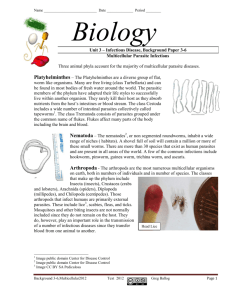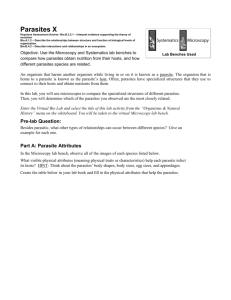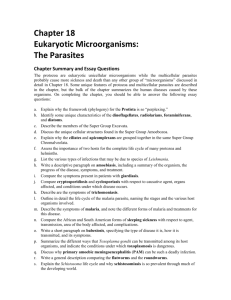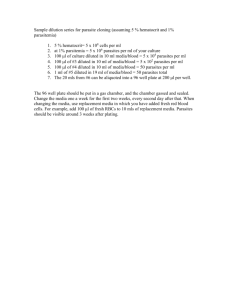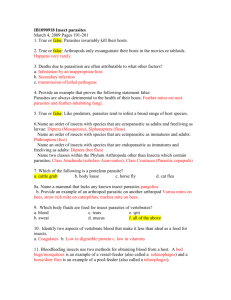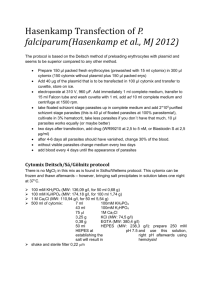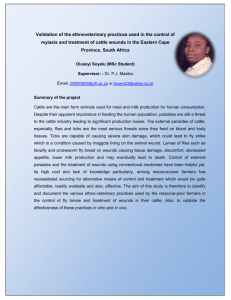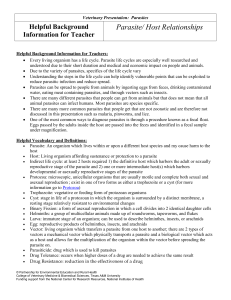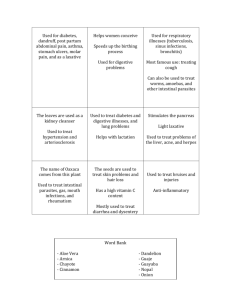AA22 Animal Science II Unit C Animal Management
advertisement
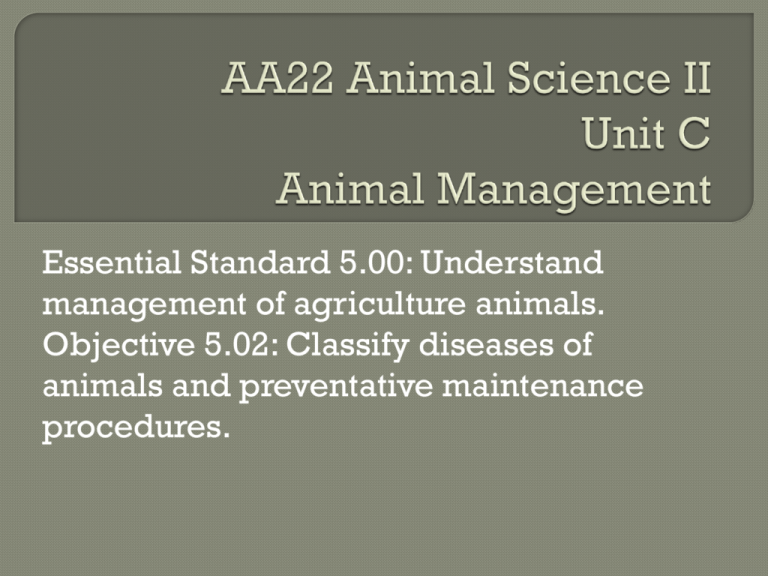
Essential Standard 5.00: Understand management of agriculture animals. Objective 5.02: Classify diseases of animals and preventative maintenance procedures. A. B. Every production farm (swine, cattle, poultry, or sheep) should establish a preventative maintenance schedule that is followed year after year. Preventative maintenance will vary depending on the type of animals you are raising. Example: cattle feedlot versus cow/calf operation. C. Preventative Maintenance Includes 1. Sanitation- prevents a wide variety of diseases and issues associated with raising livestock. i. More effective method of preventing disease compared to treating animals once they are sick. ii. Isolation of new animals is recommended to prevent spread of disease. 2. Biosecurity- protection from biological harm from living things including diseases, parasites and bioterrorism. 3. Record Keeping- keep accurate breeding records, health protocols, production records, vaccinations schedules, etc. 4. Feeding Practices- provide adequate nutrition to meet the needs of the individual animals. 5. General Management Techniques- used to control potential injuries and problems to the animals and/or workers. 6. Vaccination and Immunization- used to control a variety of diseases associated with livestock animals. 7. External Parasite Identification and Control- prevent excessive infestation, illness and potential death of livestock animals. 8. Internal Parasite Identification and Controlprevent excessive infestation, illness and potential death of livestock animals. A. Dehorning- removing horns to prevent injury to other animals or workers. 1. Dehorning young animals when horns are in button stage causes less shock and is easier to do. 2. Bleeding risk involved with dehorning older animals. 3. Methods i. Chemical- liquid, pastes or caustic sticks are used to disbud the horn before the horns attach to the skull. ii. Mechanical- used to dehorn at any stage of horn development. a. Spoons, cup or tube type- tool with a circular blade is pushed into the skin around the horn bud and then turned to remove horn. b. Barnes type- hinged tool placed over the horn that slices through skin and under the horn. c. Hot irons- a heated tool is held to horn bud to destroy horn producing cells. Bloodless method only used in button stage. d. Saws- a hand saw or obstetrical wire is used to saw through horn. Tube, cup or spoon Type Barnes or Gouger Type Hot Iron Type Obstetrical Wire or Hand Saw B. Castration- removing testicles of male animals. 1. Prevents unplanned breeding. 2. Improves ability and ease to manage animals. 4. Castration performed on all livestock species. 5. Methods i. Surgical- involves splitting or removing the lower third of the scrotum and extracting the testicles by severing the spermactic cord. Tools used include a surgical knife, emasculator, or Henderson castrating tool. ii. Bloodless- a tool such as a Burdizzio castrator or elastrator cuts off blood supply to the testicles. C. Beak Trimming Poultry- removing ½ to 1/3 of the beak. 1. Performed to prevent cannibalism. 2. Poultry in range systems should not be debeaked. 3. Methods i. Hot iron tool. ii. Infrared tool. D. Clipping Needle Teeth- removal of sharp side teeth on piglets. 1. Prevents injury to sow during nursing and littermates. 2. Method i. Disinfected clippers. E. Docking- removal of a portion of the tail. 1. Performed on sheep, pigs and sometimes dairy cattle 2. Sheep and Cattle i. Improves overall sanitation especially during reproductive procedures and parturition. ii. Methods a. Knife. b. Elastrator. c. Burdizzo. d. Emasculator. e. Electric docker. f. Hot iron docker. Elastrator Emasculator Burdizzo Hot iron docker 3. Swine i. Prevents tail biting. ii. Methods a. Side-cutting pliers. b. Hot iron dockers. A. The purpose of vaccinations is to develop immunity to diseases. B. Types of Disease 1. Non-Infectious- caused by environmental or nutrition factors rather than a specific microorganism. Typically not contagious. Examples: faulty nutrition, trauma, toxic substances, congenital defects, and metabolic disorders. 2. Infectious- caused by a specific disease causing microorganism and/or pathogen. May or may not be contagious. Examples: i. Virus- single celled eukaryotic organism. Has characteristics of both living and nonliving material, but cannot grow and reproduce outside of a living cell. Antibiotics are not effective in treating viruses. ii. Bacteria- single celled prokaryotic organism. Survive in various conditions and invade the cells of an animal’s body. iii. Protozoa- microorganism that causes disease. C. Immunity- resistance to developing a disease. 1. Types of Immunity i. Active- immunity that is acquired naturally due to exposure to substance that stimulates antibody production. Example: vaccination. ii. Passive- antibodies that are transferred from mother to baby or injected into an animal from an animal that is already immune. Example: colostrum. D. Vaccines- substances that develop resistance to disease (immunity). 1. Types of Vaccines i. Modified Live- vaccines that are alive but are weakened and have lost their disease causing ability. ii. Killed- vaccines that do not contain pathogens, but still stimulate immune response. E. Routes of Injection 1. Vaccine Injections i. Subcutaneous- under the skin. Needle angled approximately 45 degrees. ii. Intramuscular- into the muscle. Needle is held at a 90 degree angle. iii. Intranasal- into the nose. No needle used. Vaccine is deposited through small tube into the nasal cavity. 2. Medication Injections i. Subcutaneous. ii. Intramuscular. iii. Intravenous- into the vein. Needle angled approximately 25 degrees. Jugular vein is most common vein used but caution must be taken to not hit carotid artery. iv. Intradermal- into the epidermal layer of the skin. Needle angled approximately 10-15 degrees. Use your textbook to complete Activity 5.02.03 “Disease Worksheet.” F. Disease Treatment and Prevention 1. Prevention is the best way to control diseases. 2. Vaccination. 3. Biosecurity Measures i. ii. iii. iv. Cleanliness. Quarantine sick animals. Avoid exposure to disease. Isolate new animals. 4. New feeder cattle should be vaccinated as soon as they come off the truck at the farm. 5. In poultry, flock treatments using medicine in water, by sprays or dusts, and cause less stress than individual bird vaccinations and should be used if possible. A. Common Internal Parasites 1. Roundworms/Ascarids- stomach worms, pinworms, lungworms. 2. Tapeworms- broad tapeworm, beef or pork tapeworm. 3. Flukes- liver fluke. 4. Protozoa- coccidia. B. Life Cycle- important to understand the typical life cycle to effectively control internal parasites. 1. Adult female parasite lays eggs inside the host animal that pass out of the animal in feces. 2. Eggs hatch and larvae climb onto blades of grass. 3. Animal ingests larvae when grass is consumed. 4. Larvae develop into adult parasites in host organ; stomach, lungs, intestines, etc. Adult larvae deprive animals of nutrients and/or blood. C. Controlling Internal Parasites 1. The most effective method of control is prevention. 2. Control Methods i. Chemical- substances used to kill parasites. Administered orally or topically. 1. Problems with resistance to chemicals can occur. a. Test individual animals using a fecal egg count to determine if they are above the threshold for internal parasites. b. Treat animals with parasite issues. c. Use the same de-wormer (anthelmintic) until it is no longer effective. d. Sheep and goat industry have major resistance issues. The Barber pole worm is the major internal parasite that causes blood loss, anemia and death. ii. Mechanical- complete or partial removal of parasite. Example: Removing or breaking up manure contaminated with internal parasites. iii. Biological- non-chemical methods of controlling parasites. Example: Feeding forages such as lespedeza hay that contains higher levels of tannins that kill parasites. iv. Cultural/Environmental- modifies the growing environment of the parasite. Example: pasture rotation. D. Major Problems and Recommendations 1. Other than death, the most costly result of internal parasites in cattle, swine and poultry is weight loss or reduced gains. 2. The major internal parasites of poultry are several types of worms and coccidia. 3. Roundworms cause the most damage of any internal parasites for hogs. 4. Deworming pregnant sows and gilts about a week before farrowing kills the worms and prevents baby pigs from getting worms from their mother’s manure. A. Common External Parasites 1. 2. 3. 4. 5. 6. 7. Ticks- bloodsuckers. Lice- bloodsuckers and biting. Mites- cause mange. Blowfly- screwworm in larval stage. Heel Fly- cattle grub in larval stage. Horn Fly- smallest, bloodsucking species. Other kinds of flies including horsefly, housefly and stable fly. B. Controlling External Parasites 1. The most effective method of control is prevention. 2. Control Methods i. Chemical- most common method of controlling external parasites. a. Systemic insecticides absorbed through the animal’s skin are commonly used. b. Oral ingestion also used to control some external parasites. ii. Mechanical. iii. Biological. iv. Cultural/Environmental. C. Major Problems and Recommendations 1. Most external parasites of birds or poultry lower production by sucking blood. 2. The external parasite causing the greatest financial loss in beef cattle is the larva of the Heel Fly or cattle grubs because they lower rate of gain and damage hides and meat. 3. The major external parasites of swine are lice and mites. 4. Mites, bedbugs and fowl ticks hide in cracks and crevices in poultry houses during daylight, and those places must be sprayed with approved chemicals during daylight to kill those external parasites.
